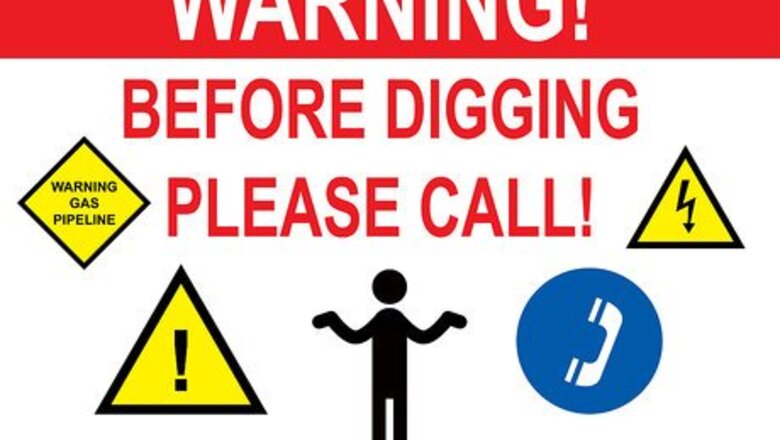
views
Removing a Whole Slab
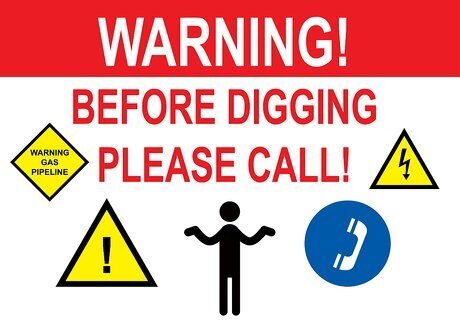
Call your utility companies. Always call your local utility companies to make sure there aren't any underground utilities beneath the concrete. Hire a professional if there are. Digging above a utility line like gas or electric can be very dangerous.
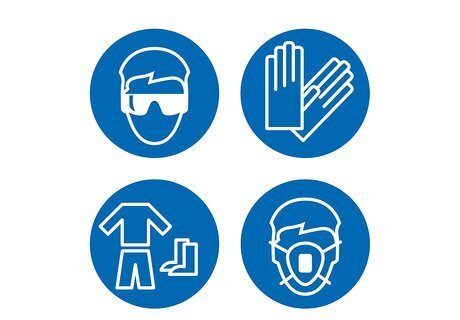
Use safety equipment. Concrete removal creates hazardous dust and sharp fragments, so protect yourself and your coworkers with safety goggles, dust masks or respirators, steel toe or other heavy boots, thick gloves, and thick clothing that covers your arms and legs. If you're going to be using power tools, especially a jackhammer, use ear protection.
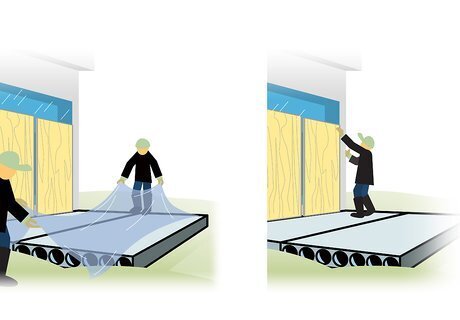
Cover the slab with plastic sheets to protect fragile items. Be careful when using plastic sheets, as they can sometimes create a slipping or tripping hazard. However, sheeting can be worthwhile if you're breaking up concrete near fragile items or structures. If you're breaking up concrete in a wide open area away from structures and other breakables, it's unlikely you'll need sheeting. Fragments of concrete can be launched great distances by the force of your hammer and tools. When in doubt, use a cover to protect the surrounding area. If you don't use plastic sheeting, protect any nearby windows and breakable objects with plywood sheets to protect the glass from concrete fragments.
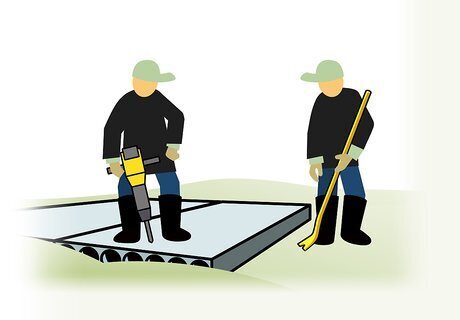
Obtain a large pry bar. Whether you're using a sledgehammer or jackhammer, you'll likely need to pry apart the pieces of concrete as you break them apart. Concrete removal generally goes quickest if you have one person breaking apart the concrete and another following along and prying the pieces apart.
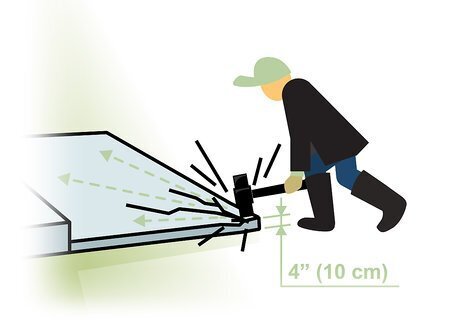
Use a sledgehammer for thin slabs. If your concrete is 4 in (10 cm) thick or less, try using a sledgehammer. Start at any existing cracks or at a corner or edge, and keep in mind that thick concrete will be easiest to break closer to its outer edges. Don’t try to swing the sledgehammer or lift it above your head; hold it at shoulder-height and let it fall onto the concrete, instead. Use the pry bar to pull apart the chunks of concrete after you break them apart. Then, move them out of the way to eliminate trip hazards. If after 10 minutes you've failed to make significant cracks or you are exhausted, you may want to try a demolition hammer.
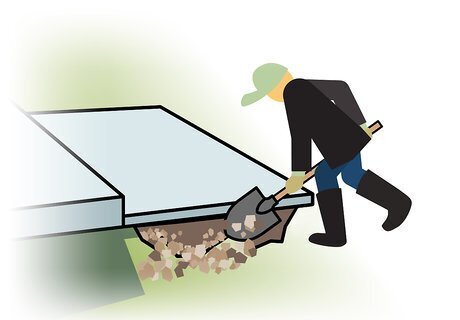
Dig underneath slabs that are difficult to break. "Undermining," or removing soil beneath the slab, will make the cement break more easily. Use a shovel to clear out the soil beneath the lip of the concrete, then strike it with your hammer. The more you undermine a slab, the easier it'll be to break. However, even undermining a little can significantly decrease the difficulty of breaking concrete. After you’ve begun to undermine, use a garden hose to loosen the dirt and wash it out from underneath the slab.
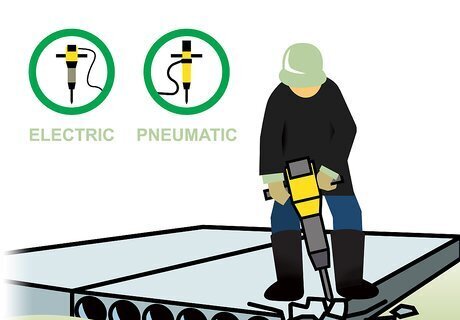
Use an electric demolition tool. A 60-pound (27.2-kg) breaker should be sufficient for most home jobs. Only rent a heavy duty pneumatic jackhammer for extremely thick or difficult to break concrete. Only use a chisel point bit to break up concrete. This concentrates force, allowing the tool to break up the concrete more efficiently. Let the weight of the machine do the job; it's not necessary to add force by pushing down. Forcing the bit may damage the tool or possibly wedge the bit. If the concrete doesn't crack immediately, stop hammering and move over a few inches. More hammering could get the drill bit stuck. Break pieces 2-3 inches (5-8 cm) away from each other to minimize chances of a stuck drill bit. Use the pry bar to pull apart chunks of concrete after you crack them apart.
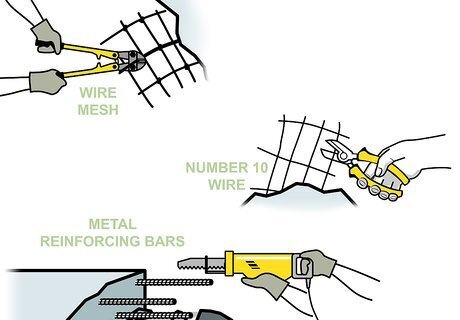
Deal with any mesh or reinforcing bars you encounter. You may encounter supports inside the concrete after you start cutting. Deal with them as you separate the chunks of concrete: If the concrete is held together by wire mesh or heavy, welded wire fabric, you'll need bolt cutters to snip it apart. Number 10 wire can be cut with side cutting pliers. Metal reinforcing bars will take much longer to cut apart. Use a reciprocating saw or an angle grinder with a cutoff blade.
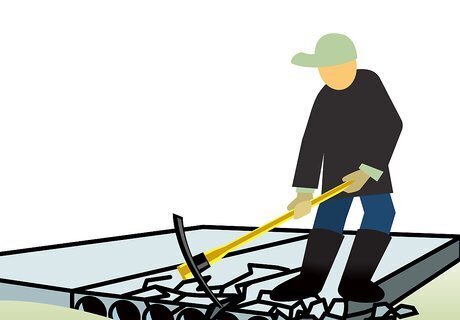
Pull apart jammed together chunks with a mattock. If chunks of concrete remain locked together, making it hard to break the surrounding area, clear the surrounding rubble. After that, you're ready to use a heavy mattock to pry locked chunks apart: Swing the pointed end into the crack between the two chunks and pry. Once the crack is wide enough, switch to the larger flat end and pry it fully apart. Pry up the opposite side of each chunk if they still won't budge.
Removing a Small Portion
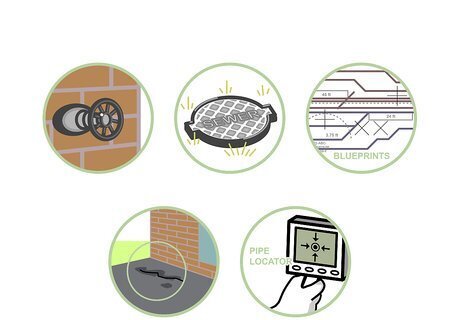
Determine where you need to break the concrete. If you are looking for a broken water or drain line and you can figure out its general location, you'll save a lot of effort and expense. Here are some things to look for: For plumbing problems, try to determine the location and depth of the underground pipes. Look for an outdoor faucet, sewer cap, or use a line locator. For water problems, look for areas where water is either bubbling up through cracks in the concrete or seeping out around the edges of the slab. For electrical lines, you may find you have to locate the conduit outside the slab area and dig up a length of it to determine where it runs. For other types of repairs, look up the construction blueprints with your municipal government or request them from the contractor who built your home.
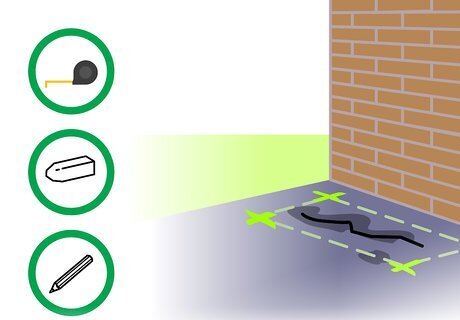
Mark the location of the portion of the slab you intend to remove. You may wish to measure distances from the slab's edge to make an even, parallel hole for less visible repairs. Use a pencil or chalk to mark off the location. Since you don’t know what is under the concrete, allow for plenty of room around your repair area to avoid causing further damage.

Shut off all relevant utilities. If you are digging toward a specific line or pipe, shut off the power or water before you begin. You don't want to risk electrocution, flooding, or a gas leak. Always call the utility company to find out the location of power lines and other dangerous items before beginning projects that involve digging.
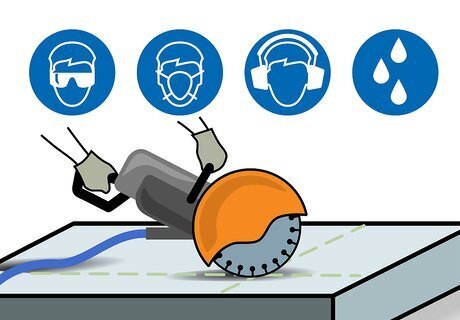
Saw the line as deeply as possible. Rent a concrete cutoff or demolition saw. Cut the line evenly to create a clean edge when your work is complete. If you are searching for a broken water pipe, you may have to enlarge the hole after the initial break is done. Be very cautious while sawing. These saws are powerful and can cause serious injury, property damage, or death if used incorrectly. Always wear a respirator or face mask to protect your lungs from cement dust and always follow the tool's user instructions carefully. Whenever possible, use a wet saw and a steady flow of water to prevent airborne dust and damage to the saw blade.
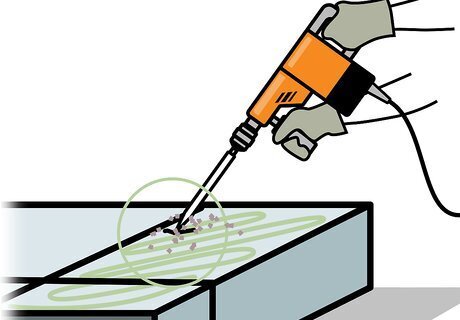
Chip the concrete near the cut. Use a heavy duty hammer drill or a breaking chisel attachment in a rotary hammer to chip the concrete next to the line you sawed. Tilt the chisel so the side you will be removing cracks loose, not the side you're keeping.

Gradually deepen the hole. Using the same tool, work the area around the cut, penetrating deeper each time until you've reached the bottom of the slab. This is the hardest part of the job, since the pieces you break off cannot come free until there is a space for them to drop into. You may need to leave tightly wedged pieces of concrete until the adjacent concrete is broken and removed.
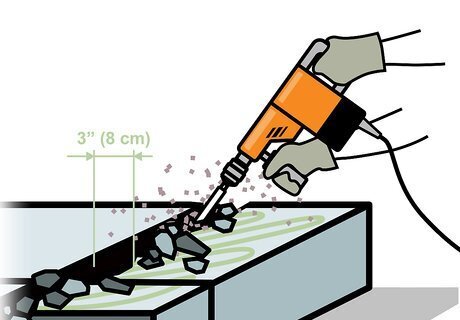
Chip inward to make the gap wider. Once a gap has been created between the concrete you're removing and the concrete that's staying, chip further with the same tool. Widen it to at least 3 inches (8 cm), or enough to fully remove the broken pieces. Keep your chisel point slanted toward the beginning hole while you work around the perimeter of the hole, so it doesn't try to penetrate straight down. If the chisel goes too deep, the bit will become lodged in its hole and will be difficult to remove. If a bit is truly stuck, you may need to use a new drill bit to break the concrete around it and free it.
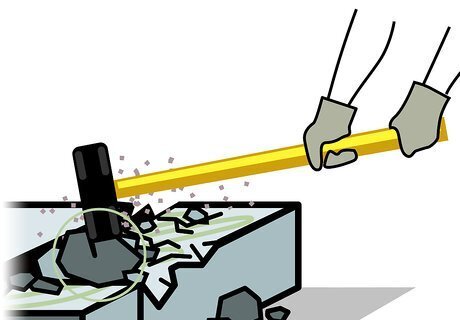
Break larger pieces using a sledgehammer or electric jackhammer. Once there is a wide enough gap to avoid damaging the concrete you wish to keep, you can use the techniques described in the section on removing a whole slab. Use a pry bar as you go for the quickest and most effective results. Do not use a jackhammer or similar power tool if you are near a water pipe, electrical line, or gas line. Remove the broken chunks of concrete from the hole as it becomes larger so you can work more comfortably and spot pipes or electrical wires more easily. Use bolt cutters to snip reinforcing mesh and an angle grinder to cut through reinforcing bars.
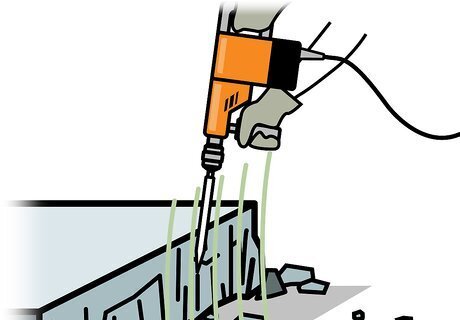
Clean up the walls of the hole. Once all the concrete is removed, chip the vertical walls of the hole to make them smooth and even. This will ensure a stronger repair (or a more attractive edge if you don't plan on replacing the concrete).
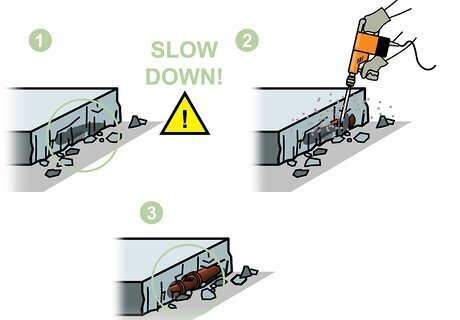
Search for the damaged pipe (if applicable). If you're trying to find a damage utility such as a water pipe, look for signs as you go, such as water puddles or stains. Once you find the pipe, you may need to continue breaking concrete along its length until you find the damaged section. As you approach the depth and location of the damaged line or pipe, slow down and swing your hammer more precisely to prevent further damage. To protect pipes and lines, refrain from hitting your hammer on the concrete directly above their suspected location underground. Avoid hitting cast iron or PVC pipes with the breaking hammer, as these are especially brittle and can easily become damaged.
Disposing of Broken Concrete

Use the rubble as fill. If you have a large hole in your yard, use some of the rubble to fill it back again. Cover any pipes or other objects with soil first to avoid damaging them with backfilled concrete.

Use a heavy-duty wheelbarrow or hand truck. Move the rubble to a larger disposal container using a heavy-duty wheelbarrow. Concrete is very heavy and can break light wheelbarrows. As an alternative, you can use a hand truck. You’ll only need to move the pieces a few inches, rather than lifting them into the wheelbarrow. Do not overload the wheelbarrow, or it could fall over and create additional work. Taking more trips with smaller loads will prevent you from overdoing it. Consider renting a power wheelbarrow.
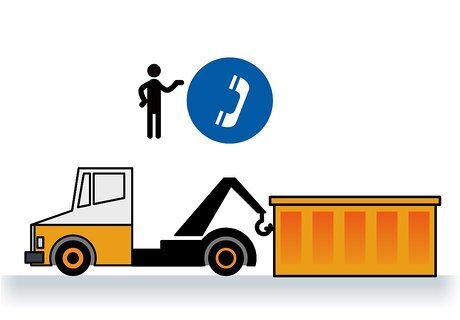
Rent a dumpster from a disposal company. If you want to get rid of a large amount of concrete, this is your best bet. Many disposal companies have a reduced rate for disposing clean broken concrete. Ask in advance how full you can load it, or you'll be forced to remove the excess concrete or pay them to do so.
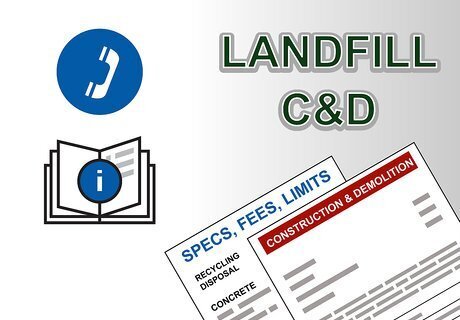
Contact landfills about the cost of disposal. In some locations, only landfills that accept "C&D" (Construction and Demolition) materials will accept concrete. The fees for landfills like this can be pricey, so it's best to check beforehand.
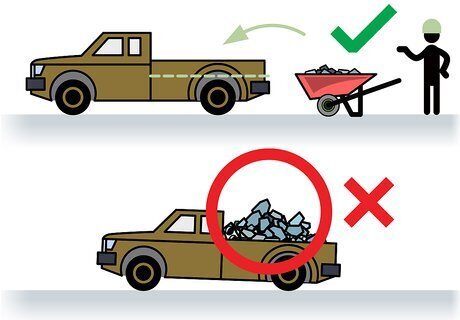
Drive the cement to the landfill. Be careful - your truck will not carry as much concrete as you think. Use a powerful pickup truck and do not fill the entire bed. Half full will likely be fine for full-sized trucks, though a quarter full would likely be best for smaller ones. You can also use a utility trailer for your truck, but be especially cautious in that case. An overly heavy trailer could smash into your truck or spill. Building supply companies may take your old concrete for free if you call them in advance and agree to deliver it yourself.

Upcycle broken concrete in another home project. Broken concrete can be used to make a raised planting bed. You can also use pieces of concrete similar to pavers to create a footpath or stepping stones. Chunks with an interesting shape can be painted and used to make garden ornaments, too. You could also arrange the pieces into a circle to create a backyard fire pit.



















Comments
0 comment